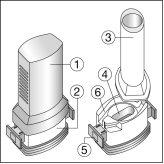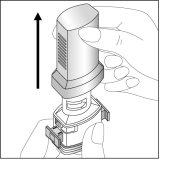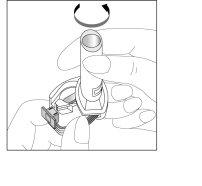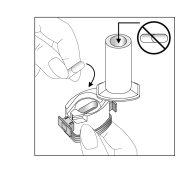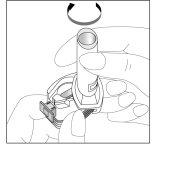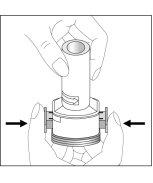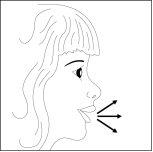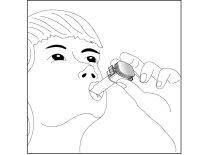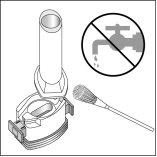
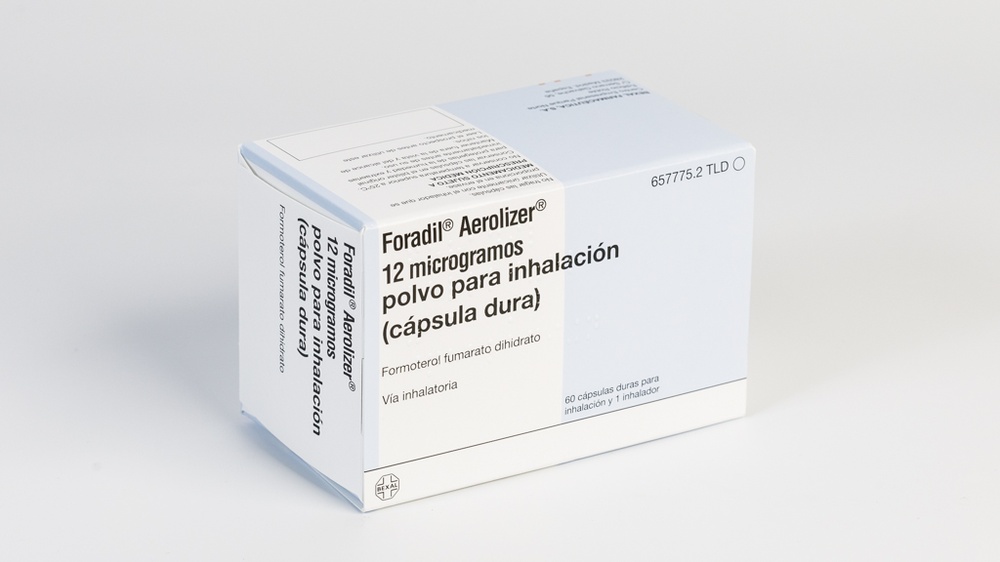
FORADIL AEROLIZER 12 micrograms INHALATION POWDER (HARD CAPSULE)


How to use FORADIL AEROLIZER 12 micrograms INHALATION POWDER (HARD CAPSULE)
Introduction
Package Leaflet: Information for the User
Foradil Aerolizer 12 micrograms inhalation powder (hard capsule)
Formoterol fumarate dihydrate
Read all of this leaflet carefully before you start using this medicine because it contains important information for you.
If you have any further questions, ask your doctor or pharmacist.
|
Contents of the pack:
- What is Foradil Aerolizer and what is it used for
- What you need to know before you use Foradil Aerolizer
- How to use Foradil Aerolizer
- Possible side effects
- Storing Foradil Aerolizer
- Contents of the pack and other information
1. What is Foradil Aerolizer and what is it used for
Foradil Aerolizer contains a substance called formoterol fumarate dihydrate. It belongs to a group of medicines called “bronchodilators” or “long-acting beta2 agonists”.
This medicine is used:
- Together with inhaled corticosteroids as maintenance treatment in moderate to severe asthma.
- To prevent breathing difficulties caused by inhaling allergens (substances that cause allergy), cold air, or exercise.
- As maintenance treatment to relieve symptoms in patients with chronic obstructive pulmonary disease (COPD).
2. What you need to know before you use Foradil Aerolizer
Follow carefully all instructions given to you by your doctor or pharmacist, even if they are different from those contained in this leaflet.
Do not use Foradil Aerolizer:
- If you are allergic to formoterol or any of the other ingredients of this medicine (listed in section 6).
Talk to your doctor about the risks and benefits of treating your asthma with this medicine.
Warnings and precautions
Consult your doctor or pharmacist before you start using Foradil Aerolizer.
Be especially careful with this medicine:
- If you have any heart disease or any abnormality of the heart rhythm (called “prolonged QT interval” detected on your electrocardiogram).
- If you have high blood pressure.
- If you have hyperthyroidism (a disease of the thyroid gland).
- If you have an aneurysm (a localized dilation of an artery caused by degeneration or weakening of the vascular wall).
- If you are diabetic or if your doctor has told you that you have an intolerance to some sugars, consult your doctor before taking this medicine.
Treatment with Foradil Aerolizer may lead to an increase in blood sugar levels. Therefore, if you are diabetic, you will need to monitor your blood sugar levels.
- If you have a pheochromocytoma (a tumor of the adrenal gland that can affect blood pressure).
- If you have asthma, do not use Foradil Aerolizer as your only medicine for asthma. Use this medicine only with an inhaled corticosteroid (ICS).
- If you feel that you have difficulty breathing or wheezing during the use of this medicine, you should continue using Foradil Aerolizer, but you should see your doctor as soon as possible, as you may need additional treatment.
Do not use this medicine to relieve sudden wheezing. Always carry with you a short-acting beta2 agonist (a rescue inhaler prescribed by your doctor) to treat sudden asthma symptoms.
Important information about this medicine
- Do not change or stop any of your treatments for controlling or treating your respiratory problems, including inhaled corticosteroids. Your doctor will adjust your treatment according to your needs.
- Once your asthma is well-controlled, your doctor may consider it appropriate to gradually reduce the dose of this medicine.
- If you are well-controlled with an inhaled corticosteroid, you should not use this medicine.
- Do not use this medicine if you only need to use a short-acting beta2 agonist (rescue inhaler) from time to time.
- While using Foradil Aerolizer, do not use other medicines with a similar effect, such as salmeterol (long-acting beta2 agonists).
- Do not start treatment with this medicine or increase the recommended dose by your doctor while you are having an asthma attack.
Treatment with Foradil Aerolizer may produce a low level of potassium in the blood. This can make you more susceptible to an abnormal heart rhythm. Therefore, your doctor may need to monitor your potassium level, especially if you have severe asthma.
Consult your doctor if you have any doubts about how Foradil Aerolizer works or why it has been prescribed for you.
Elderly patients (65 years of age and older)
If you are 65 years of age or older, you can use this medicine at the same dose as adults.
Children and adolescents
Foradil Aerolizer is not suitable for children under 6 years of age.
Children from 6 years of age should only use this medicine if they are able to handle it correctly (see section "How to use the capsules of this medicine with your inhaler"). They should only use the inhaler under the supervision of an adult.
Using Foradil Aerolizer with other medicines
Tell your doctor or pharmacist if you are taking or have recently taken or might take any other medicines. This is especially important if you are taking any of the following medicines:
- Monoamine Oxidase Inhibitors (MAOIs) or tricyclic antidepressants (TCAs), used to treat depression and mood disorders.
- Sympathomimetic agents, which are medicines similar to adrenaline and are used to treat asthma and nasal congestion.
- Antihistamines, which are commonly used to prevent or treat the main symptoms of an allergic reaction.
- Steroids, which are often used to treat asthma and other inflammatory diseases.
- Diuretics, which are used to treat edema (water retention), heart failure, and high blood pressure.
- Beta-blockers, used to treat high blood pressure, heart failure, angina, anxiety, and abnormal heart rhythm. Certain eye drops used to treat glaucoma may contain beta-blockers.
- Quinidine, disopyramide, and procainamide, used to treat abnormal heart rhythm.
- Phenothiazine derivatives, used to control mental disorders such as schizophrenia, mania, psychotic states, and anxiety.
- Digitals, used to treat heart failure and abnormal heart rhythm.
- Xanthine derivatives, which are used to treat asthma and chronic obstructive pulmonary disease.
- Macrolides (e.g., erythromycin) used to treat bacterial infections.
- Anesthetics such as halogenated hydrocarbons (e.g., halothane) used to produce anesthesia during surgery.
- Anticholinergics (e.g., ipratropium bromide) used to treat gastrointestinal, genitourinary, and other disorders.
It may be necessary for your doctor to change or even stop the dose of one of the medicines.
If your doctor has prescribed you other medicines that you must take regularly to treat your respiratory disease, it is important that you continue to take them as usual and do NOT STOP or reduce the dose, even if you start to feel much better.
Pregnancy and breast-feeding
If you are pregnant or breast-feeding, think you may be pregnant or are planning to have a baby, ask your doctor or pharmacist for advice before taking this medicine.
Pregnancy
Do not use this medicine during pregnancy unless your doctor has told you to. He or she will inform you of the potential risk of taking Foradil Aerolizer during pregnancy.
Breast-feeding
You should consult your doctor before taking Foradil if you are breast-feeding.
Driving and using machines
In some patients, this medicine may cause dizziness. If you feel dizzy, do not drive, use machines, or perform any other activity that requires your attention.
Foradil Aerolizer contains lactose
This medicine contains lactose. It may cause allergic reactions in patients with cow's milk protein allergy. If your doctor has told you that you have an intolerance to some sugars, consult with him before taking this medicine.
Use in athletes
Athletes are informed that this medicine contains a component that may result in a positive doping control test.
3. How to use Foradil Aerolizer
Follow the administration instructions for this medication contained in this prospectus or as indicated by your doctor. In case of doubt, consult your doctor or pharmacist.
Your doctor will indicate the amount and frequency of use of Foradil Aerolizer according to your needs. Do not exceed the recommended dose. Remember to use your medication.
The effect of the dose lasts up to 12 hours.
Do not swallow the capsules. They must be used by inhaling the contents with the Aerolizer inhaler.
Use in adults (including elderly people)
Maintenance treatment of asthma
For asthma treatment, you will always be prescribed Foradil Aerolizer along with an inhaled corticosteroid.
- The normal recommended dose is 1 capsule inhaled twice a day. In more severe cases, 2 capsules may be administered twice a day.
- In addition to the normal dose, you may occasionally need 1 or 2 additional capsules daily to relieve usual symptoms. If you need to take these additional doses more than twice a week, consult your doctor as it may indicate a worsening of the disease.
- The maximum recommended daily dose for adults is 4 capsules.
Prevention of breathing difficulties caused by inhaling allergenic substances, cold air, or exercise
- The recommended dose is 1 capsule inhaled at least 15 minutes before exercise or exposure to the allergen or cold air.
- In some cases, your doctor may advise you to use 2 capsules to prevent wheezing and bronchospasm.
Maintenance treatment of COPD (chronic obstructive pulmonary disease)
- The recommended dose is 1 capsule inhaled twice a day, which must be administered with the inhaler as described in the section "How to use the capsules of this medication with your inhaler". In more severe cases, 2 capsules may be inhaled twice a day.
Use in children and adolescents (from 6 years of age)
This medication is not recommended for children under 6 years of age. See the "Children and adolescents" section of section 2. What you need to know before you start using Foradil Aerolizer.
Maintenance treatment of asthma
- The recommended dose is 1 capsule inhaled twice a day.
- The maximum recommended daily dose is 2 capsules per day.
Prevention of breathing difficulties caused by inhaling allergenic substances, cold air, or exercise
- The recommended dose is 1 capsule inhaled at least 15 minutes before exercise or exposure to the allergen or cold air.
How to use the capsules of this medication with your inhaler
Follow the instructions below to learn how to use this medication.
Use the capsules of this medication only with the inhalerprovided in the package. The Aerolizer inhaler included in the package has been specially developed for use with this medication.
Remove the capsule from the blister just before use. Make sure your fingers are completely dry so that the capsule does not get wet.
Do not swallow the capsule. The powder in the capsule is for inhalation only.
| The Aerolizer inhaler consists of the following parts:
The base consists of:
|
Instructions for correct use
|
|
|
Hold the inhaler base firmly and turn the mouthpiece in the direction of the arrow. |
|
IMPORTANT: Do not place the capsule in the mouthpiece! |
|
|
|
Note: The capsule may break into small gelatin fragments that can enter your mouth or throat. The gelatin is edible and therefore not harmful to health. |
|
|
|
Note: You should hear a noise as the capsule spins in the space above the capsule compartment. If you do not hear this noise, open the capsule compartment and check that it is loose inside the compartment. Repeat step 7. DO NOT TRY to release the capsule by pressing the buttons repeatedly. |
| |
|
|
|
Questions / How to avoid problems
- How can I avoid breaking the capsule into small fragments?
The capsules can break when you press the blue buttons (step 5) and small fragments can enter your mouth or throat when you inhale. You can avoid this:
- Pressing the blue buttons only once.
- Keeping the capsules in their original packaging (blister) before use.
- Storing the capsules at a temperature not exceeding 25°C.
- Protecting the capsules from moisture.
- Are the capsule fragments harmful to health?
No. The capsule is made of edible gelatin that is not harmful to health.
Any gelatin fragment that enters your mouth or throat can be swallowed.
- How can I release the capsule if it is stuck in the compartment?
Open the Aerolizer, turn it upside down, and gently tap the bottom.
- What can I do if the blue buttons get stuck?
Gently pull the blue buttons back to their initial position with the help of the lateral projection pieces.
- How can I know if I have actually taken the dose?
- You will hear a noise when you inhale through the Aerolizer.
- You will have a sweet taste in your mouth, due to the lactose. You may notice powder in the back of your throat, which is normal.
- The capsule will be empty.
- How can I remove the powder from the inside of the Aerolizer?
- Use a dry cloth or a soft brush.
- Remember to never wash the Aerolizer.
If you use more Foradil Aerolizer than you should
If you accidentally use more Foradil Aerolizer than your doctor prescribed, you may feel nausea or vomiting, or you may experience tremors, headache, dizziness (possible symptoms of high blood pressure), rapid heartbeat, or drowsiness. Inform your doctor immediately or go to the nearest emergency room. You may need medical attention. Bring the package of your medication with you.
In case of overdose or accidental ingestion, consult the Toxicology Information Service. Phone 91 562 04 20.
If you forget to use Foradil Aerolizer
Do not take a double dose to make up for forgotten doses. If you forget a dose, use it as soon as you realize. If it is almost time for the next dose, skip that dose and continue with your usual dosage.
If you have any other questions about the use of this medication, ask your doctor or pharmacist.
4. Possible side effects
Like all medications, this medication can cause side effects, although not everyone will experience them.
In some situations, severe asthma attacks (severe increase in shortness of breath, cough, wheezing, or chest tightness, which can lead to hospitalization) have been observed.
Some effects can be serious:if you experience any of these side effects, stop taking this medication and inform your doctor immediately:
Uncommon:may affect up to 1 in 100 people
- Bronchospasm (contraction of the bronchi causing difficulty breathing) with wheezing or cough and difficulty breathing.
Very rare:may affect up to 1 in 10,000 people
- Allergic reactions, for example, if you feel weak (have low blood pressure), if you get a skin rash or experience itching or swelling of the face.
Frequency not known:cannot be estimated from the available data
- Muscle weakness, muscle spasms, and/or abnormal heart rhythm (these symptoms could indicate that you have low potassium levels in your blood).
- Irregular heartbeat (including rapid heartbeat).
Chest pain of an oppressive nature (symptom of angina pectoris).
Other side effects:
Common:may affect up to 1 in 10 people.
- Headache
- Tremors
- Palpitations
Uncommon:may affect up to 1 in 100 people.
- Agitation
- Anxiety
- Nervousness
- Sleep disorders
- Rapid heartbeat
- Throat irritation
- Dry mouth
- Muscle cramps
- Muscle pain
- Dizziness
Very rare:may affect up to 1 in 10,000 people.
- Nausea
- Taste disturbance
- Swelling of the hands, ankles, or feet
- Prolongation of the QT interval
Frequency not known:cannot be estimated from the available data.
- Excessive thirst, frequent urination, and fatigue over a long period (a possible indication of high blood sugar levels).
- Cough
- Skin rash
- Headache and dizziness (symptoms of high blood pressure).
Some of these side effects may disappear on their own.
Reporting side effects
If you experience any side effects, consult your doctor or pharmacist, even if they are possible side effects that do not appear in this prospectus. You can also report them directly through the Spanish Pharmacovigilance System for Human Use Medicines www.notificaRAM.es. By reporting side effects, you can contribute to providing more information on the safety of this medication.
5. Conservation of Foradil Aerolizer
Keep this medication out of sight and reach of children.
Do not use this medication after the expiration date that appears on the package. The expiration date is the last day of the month indicated.
Do not store at a temperature above 25°C.
Keep in the original packaging (blister pack) along with the inhaler to protect it from moisture.
Always discard the old inhaler and use the new one provided in the package.
Medications should not be thrown down the drain or into the trash. Deposit the packages and medications you no longer need in the SIGRE collection point at the pharmacy (or any other medication waste collection system). Ask your pharmacist how to dispose of the packages and medications you no longer need. This will help protect the environment.
6. Package contents and additional information
To request more information about this medication, contact your doctor or pharmacist.
Composition of Foradil Aerolizer:
- The active ingredient is formoterol fumarate dihydrate.
- The other components are lactose monohydrate (which contains milk proteins) and gelatin.
Appearance of the product and package contents
The Foradil Aerolizer capsules are packaged in blister packs.
Each package contains 60 hard capsules and an inhaler.
Each Foradil Aerolizer hard capsule contains 12 micrograms of formoterol fumarate dihydrate and must be used with the Aerolizer inhaler provided in the package.
Marketing authorization holder and manufacturer
Holder
BEXAL FARMACÉUTICA, S.A.
Centro Empresarial Parque Norte
Edificio Roble
C/ Serrano Galvache, 56
28033 Madrid
Manufacturer
Novartis Farmacéutica, S.A.
Gran Via de les Corts Catalanes, 764
08013 Barcelona
Spain
Novartis Pharma GmbH
Roonstrasse 25
90429 Nürnberg
Germany
Salutas Pharma GmbH
Otto-von-Guericke-Allee 1
39179 Barleben
Germany
Date of the last revision of this prospectus:October 2022
Detailed information about this medication is available on the website of the Spanish Agency for Medicines and Health Products (AEMPS) http://www.aemps.gob.es/

How much does FORADIL AEROLIZER 12 micrograms INHALATION POWDER (HARD CAPSULE) cost in Spain ( 2025)?
The average price of FORADIL AEROLIZER 12 micrograms INHALATION POWDER (HARD CAPSULE) in October, 2025 is around 22.68 EUR. Prices may vary depending on the region, pharmacy, and whether a prescription is required. Always check with a local pharmacy or online source for the most accurate information.
- Country of registration
- Average pharmacy price22.68 EUR
- Availability in pharmaciesSupply issue reported
- Active substance
- Prescription requiredYes
- Manufacturer
- CompositionLACTOSA MONOHIDRATO (c.s.p. 25 mg mg)
- This information is for reference only and does not constitute medical advice. Always consult a licensed doctor before taking any medication. Oladoctor is not responsible for medical decisions based on this content.
- Alternatives to FORADIL AEROLIZER 12 micrograms INHALATION POWDER (HARD CAPSULE)Dosage form: PULMONARY INHALATION, 12 mcg/actuationActive substance: formoterolManufacturer: Chiesi España S.A.U.Prescription requiredDosage form: PULMONARY INHALATION, 12 microgramsActive substance: formoterolManufacturer: Viatris Healthcare LimitedPrescription requiredDosage form: PULMONARY INHALATION, 12 MCGActive substance: formoterolManufacturer: Laboratorio Aldo Union S.L.Prescription required


